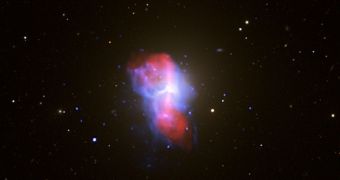Supermassive black holes, with a mass approximately a billion times that of our Sun, have been thought to reside at the very heart of the biggest galaxies, including our own. A recent computer simulation, corroborated with data obtained from the Chandra X-Ray Observatory, indicated that one of these black holes generates enormous nested bubbles of hot gas which help it control its own growth, as well as the birth of stars in the nearby region.
A team of experts, including astronomer Mateusz Ruszkowski from the University of Michigan, has been able to depict this previously unseen (and still contested) phenomenon taking place at the core of the M84 elliptical galaxy located 55 million light years away from us. They believe spiral galaxies, like our Milky Way, are less likely to host such processes in their core black holes. As material feeds the black hole in time, the hole emits jets of radiation and particles on whose tips these enormous Russian doll-like blobs form.
Eventually, these bubbles burst, releasing tremendous amounts of heat into the colder surrounding gas masses which would otherwise help stars form. When one bursts, it reveals another one that has been growing inside it in a continuous process. The duration between the bursts was determined to be constant and calculated to be of about 10 million years. This bubbling activity prevents black holes from growing uncontrollably.
"If you can eject energy from the central black hole, you can solve two problems at the same time: You can starve the black hole and also heat the gas so that stars will not be forming as efficiently," explained Ruszkowski for National Geographic. "We think certain instabilities are formed on the interface between the bubble and the surrounding medium and these instabilities shred and puncture this bubble, and the stuff that is inside them, this hot plasma, is spilling out and mixing with the surrounding gas," he added, as cited by Space.

 14 DAY TRIAL //
14 DAY TRIAL //